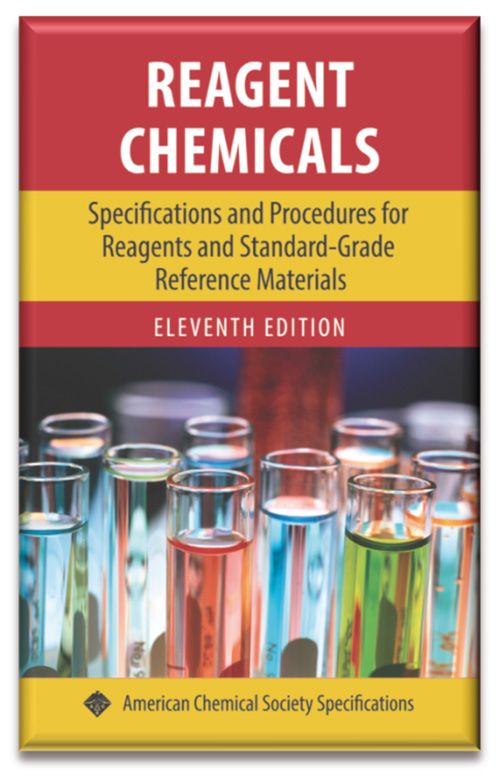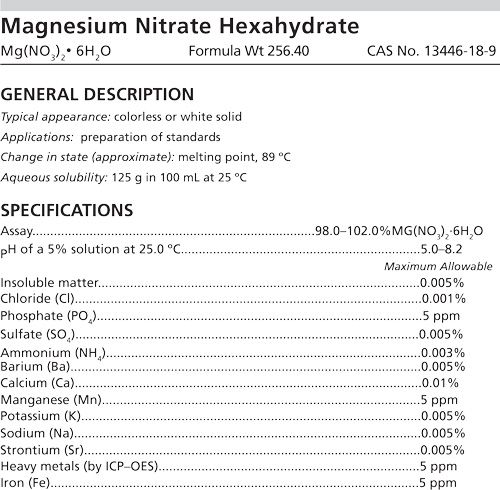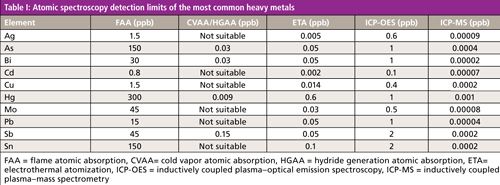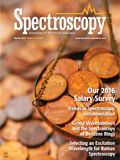Replacing Traditional Heavy Metals Testing with Modern Plasma-Based Spectrochemical Techniques
This month’s column presents an overview of the new 11th edition of the ACS Book of Reagent Chemicals and discusses some of the updated methods, and new procedures being adopted. In particular, we focus on new plasma based spectrochemical methodologies for the determination of heavy metals in reagent chemicals, which have replaced the 100 year-old test using precipitation and colorimetric measurement of the metal sulfides.
This month’s column presents an overview of the new 11th edition of the American Chemical Society’s (ACS) book on reagents and reference materials, Reagent Chemicals, and discusses some of the updated methods and new procedures being adopted. In particular, we focus on new plasma-based spectrochemical methodologies for the determination of heavy metals in reagent chemicals, which have replaced the 100-year-old test using precipitation and colorimetric measurement of the metal sulfides.
In June 2016, the 11th edition of the American Chemical Society’s (ACS) book on reagents and reference materials, Reagent Chemicals, will be officially published, which will be the culmination of seven years work for 25 dedicated analytical chemists supported by their affiliated organizations who have served on the ACS Committee on Analytical Reagents (1). This new compendium will reflect new methodology, updated procedures, and more-stringent specifications with regard to chemical reagents used for analytical testing purposes. The front cover of the book is shown in Figure 1.

Figure 1: The front cover of the ACS book ReagentChemicals.
The process of updating procedures and setting new specifications is a time-consuming process and can sometimes take years to complete. By carrying out various testing protocols, including sample preparation and spike recovery procedures, it ensures that new methods are rugged, robust, and will stand up to scrutiny wherever the book is used around the world. Many standards organizations and federal agencies that set guidelines, specifications, and analytical testing methods-including the United States Pharmacopeia (USP) (2) and the U.S. Environmental Protection Agency (EPA) (3)-require the use of ACS-grade reagent chemicals in many of their test procedures. For that reason, it has become the de facto reference book worldwide for the chemicals used in high-purity laboratory applications. This article provides an overview of the new book and in particular focuses on the new plasma-based spectrochemical methodology for carrying out the determination of a suite of heavy metals in reagent chemicals.
What Is a Reagent Chemical?
The specifications in this book are intended to serve for reagent chemicals and standard-grade reference materials to be used in precise analytical work of a general nature. The term reagent-grade chemical implies that it is a substance of sufficient purity to be used in most chemical analyses or reactions. Standard-grade reference materials are suitable for preparation of analytical standards used for a variety of applications, including instrument calibration, quality control, analyte identification, method performance, and other applications requiring high-purity materials. It is recognized that there may be special uses for reagents and standard-grade reference materials, which may need to conform to more rigorous specifications. Therefore, where necessary, some of the specifications include requirements and tests for certain specialized uses. However, it is impossible to include specifications for all such uses, and thus, there may be occasions when it will be necessary for the analyst to further purify reagents known to have special purity requirements for certain uses.
Historical Perspective
There is a very proud tradition in the ACS Committee on Analytical Reagents, which dates back more than 100 years. It evolved from the Committee on the Purity of Chemical Reagents, which was established in 1903. Analysts at that time were concerned with the quality of reagents available and by the discrepancies between labels and the actual purity of the materials. The committee’s role in resolving these issues expanded rapidly after its 1921 publication of specifications for ammonium hydroxide and hydrochloric, nitric, and sulfuric acids. Specifications appeared initially in Industrial & Engineering Chemistry and later in its Analytical edition. In 1941, the existing specifications were reprinted in a single pamphlet. Revisions and new specifications were later gathered into a book, the 1950 edition of Reagent Chemicals, and new editions appeared regularly thereafter.
The commonplace introduction of instrumentation into analytical laboratories, beginning in the late 1950s, resulted in dramatic improvements in the sensitivity and accuracy of analytical measurements. As a result, the specifications for reagent chemicals and the tests measuring their purity were improved so that the methods would be as accurate and cost-effective as possible. In many cases, these improved methods were able to detect impurities previously found to be absent. The eighth edition, which became official in 1993, substantially changed and updated the general procedures and attempted to make the book easier to read. The ninth edition, which became official in 2001, eliminated and simplified some of the tedious classical procedures for trace analysis and added instrumental methods where possible. The 10th edition continued the trend of removing and replacing more of these outdated methods of analysis, and included the use of plasma-based spectrochemical techniques for the very first time (4).
11th Edition
Some of the many changes in the 11th edition include all of the additional supplements posted online since the publication of the 10th edition in 2009, the removal of some obsolete test methods, clearer instructions for many of the existing ones, and also the introduction of many new methods. Overall, the safety, accuracy, and ease of use in specifications for approximately 70 of the 430 listed reagents have been improved, and seven new reagents have been added. There are also numerous minor changes, such as the incorporation of the 2011 International Union of Pure and Applied Chemistry (IUPAC), including the recalculation and redefinition of some atomic weights. In particular, there are several changes and additions worth noting:
· The old heavy metal, sulfide precipitation test method is still valid, but has been replaced with inductively coupled plasma–optical emission spectroscopy (ICP-OES) for more than 50 reagent chemicals.
· The use of inductively coupled plasma–mass spectrometry (ICP-MS) is highly recommended for analyzing many of the ultrahigh-purity acids and chemicals.
· The replacement of atomic absorption (AA) with plasma-based techniques, as long as method validation is carried out.
· The replacement of polarography for measuring carbonyl impurities with gas chromatography–mass spectrometry (GC–MS).
· New methodologies introduced for the first time include liquid chromatography–mass spectrometry (LC–MS) and headspace gas chromatography (HS-GC) analysis.
· The continuation of the green chemistry initiative, which incorporates fewer toxic chemicals in existing test methodologies.
Previous improvements from the 10th edition were intended to make the book easier to use, including a chemical abstracts service (CAS) number index, a separate index for the standard-grade reference materials, complete assay calculations with titer values, an updated table of atomic weights, frequently used mathematical equations, a quick reference page on how to read a monograph, division of the book into parts, and a detailed table of contents for each section. An example of a typical reagent chemical monograph from the 11th edition is shown in Figure 2.

Figure 2: A typical specification from the 11th edition of the ACS book Reagent Chemicals.
Each specification is then accompanied with a detailed description of the tests required to carry out the measurement of each of the analytes listed in the monograph. Where more information is required, the monograph directs readers to the relevant page in the book describing the test in greater detail. An example of this is the replacement of the sulfide precipitation colorimetric test for heavy metals with a brand new section on optical plasma spectrochemistry.
Heavy Metals Test
The old sulfide precipitation colorimetric method for heavy metals in reagent chemicals is very similar to the method described in The United States Pharmacopeia and The National Formulary (USP-NF) General Chapter 231 (5), which is a colorimetric test based on precipitation of the metal sulfide in a sample and comparing it to a lead standard. This USP method is being replaced by two new chapters: Chapter 232, which defines the elemental impurity limits (6) and Chapter 233, which describes the plasma-based analytical procedures and validation protocols to meet those limits (7). The ACS Committee on Reagent Chemicals had many discussions and meetings with USP personnel during the drafting and writing of new plasma-based methods. So let’s take a closer look at the traditional ACS sulfide precipitation method and the new plasma spectrochemical techniques that are replacing it.
Sulfide Colorimetric-Precipitation Procedure
Colorimetric analytical methods have been used in analytical chemistry for more than 100 years and are based on measuring color changes of solutions that arise from specific chemical interactions with the analyte elements. The traditional colorimetric test for heavy metals in chemical reagents or pharmaceutical matrices is based on a chemical reaction of the heavy metal with a sulfide solution, and compared with a standard prepared from a stock lead solution. It relies on the ability of heavy elements such as lead, mercury, bismuth, arsenic, antimony, tin, cadmium, silver, copper, and molybdenum to react with the sulfide at pH 3–4 to produce a precipitate of the metallic sulfide that is then compared with a lead standard solution. It is used to demonstrate that the metallic impurities colored by sulfide ions under the specific test conditions do not exceed a predefined limit.
One of the many drawbacks of this approach is the assumption that formation of the sulfides in the sample is very similar to the formation of the lead standard solution and is not affected by the sample matrix. However, since many metals behave very differently, the method requires that the visual comparison is performed very quickly after the precipitate has formed. Unfortunately, analysts can differ in their interpretation of the color change, so different analysts may not consistently read the sample and standard solutions correctly each time.
Another limitation of the technique is that the sample preparation procedure for some chemicals involves ashing at high temperature and acid dissolution of the sample residue, which is prone to sample losses particularly for volatile elements like mercury. The loss of metals is also matrix-dependent, and because the procedures are time-consuming and labor-intensive, recoveries can vary significantly among different analysts.
For all these reasons, the 11th edition of the book has started the process of replacing the sulfide precipitation test for heavy metals in a number of reagent chemicals with ICP-OES. The first suite will include those where the maximum allowable concentrations are at an appropriate level for the technique and where the spectral and matrix-induced interferences are well-understood and easily compensated. In addition, the use of ICP-MS is encouraged for the analysis of ultratrace reagents and acids where ICP-OES is not suitable based on its inferior detection capability. However, it is important to emphasize that the use of the older, more traditional techniques will still be allowed for many chemicals because in many parts of the world modern analytical techniques are either not available or can be extremely cost-prohibitive to purchase.
Plasma-Based Spectrochemical Techniques
OES using ICP as the excitation source is widely recognized as being an extremely rapid technique to carry out multielement analysis in various sample matrices (8). Whereas AA is used to determine small numbers of elements in solution, ICP-OES is used for multielement determinations or when high sample throughput is required. This technique is applicable to determine ultratrace elemental levels in many of the reagent chemicals specified in the book, including Ag, As, Bi, Cd, Cu, Hg, Mo, Pb, Sb, and Sn and all the elements that can be determined by AA (Ca, Ba, Na, K, Li, Mn, and Fe). The first phase of the changeover to the plasma emission technique, which has occurred in the 11th edition of the book, will lead to the eventual elimination of both the sulfide precipitation method and atomic absorption spectrometry.
To achieve the specifications, many of the reagents can simply be dissolved with deionized water, acidified with 5% nitric acid, made up to volume, and aspirated directly into the instrument’s sample introduction system. However, for analytical reagents that are more difficult to get into solution, an acid dissolution procedure using hot plate or microwave digestion might be required. For extremely low ultratrace specifications, such as in high-purity mineral acids, the samples may need to be preconcentrated by evaporation under clean air conditions and made up to volume using 5% nitric acid, before analysis by ICP-OES, or analyzed directly by ICP-MS. Additionally, if the matrix of the reagent chemical is spectrally complex, such as iron, chromium, tungsten, and molybdenum salts, interference-free analyte emission lines may be difficult to find. If this is the case, the use of ICP-MS is strongly recommended, as long as the method protocol can be validated (9).
It’s also important to point out that in the ICP-based ACS procedure, specific wavelengths are suggested because of the strong possibility that the reagent chemical matrix will produce a spectral- or matrix-derived spectral interference on one or more of the suite of analyte elements. This is very different to the USP methodology for elemental impurities in pharmaceutical and nutraceutical materials, which provides generic procedures and relies on a comprehensive set of validation protocols to ensure the quality of the data.
Detection Limits, Sensitivity, and Linear Dynamic Range
To decide which technique is most suitable, limits of detection, sensitivity, and linear dynamic range should be investigated and estab-lished for each individual analyte line or wavelength on the particular instrument being used. A list of typical detection limits of all the atomic spectroscopy techniques is given in the book to make an assessment of whether the technique of choice is suitable for the element being determined at the specification defined in the particular reagent chemical being tested. Table I gives the atomic spectroscopy detection limits in parts per billion (ppb) of the most common heavy metals (10).

The required detection capability will also depend on the sample preparation technique being used. For example, the weight of the sample and the final volume will impact the concentration of the heavy metals in solution, as shown in Table II.

Consideration should also be given to the linear dynamic range of the particular wavelength being selected for the analysis. Although this will vary slightly depending on the type of instrument and viewing configuration used, most ICP-OES systems on the market are capable of achieving linear dynamic ranges of approximately five orders of magnitude, respectively. The book also emphasizes that the manufacturer’s application-specific methodology should be followed and, if needed, with reference literature in the public domain for sensitivity, detection limits, and linear dynamic range of the emission lines being used for the analysis.
Approach to Interferences
In general, plasma-based spectrochemical techniques are mostly prone to spectral-type overlaps and matrix suppression effects produced by other matrix components in the sample. These types of interferences must be fully investigated in the method-development stage, before accurate multielement determinations can be carried out. Special attention must also be paid to the possibility of external contamination during sample preparation and analysis, especially if ultratrace determinations are being carried out. These external contamination sources can not only affect the accuracy of analyte recoveries, but they can also impact the detection capability by generating unforeseen spectral and matrix-induced interferences.
The use of an internal standard is usually required because it compensates for the physical and matrix interferences resulting from differences in sample transport efficiencies or excitation conditions between the sample matrix and calibration solutions. The choice of internal standard should be left to the analyst because the optimum selection will depend on a number of different factors. However, it is very important that the internal standard element chosen is not present in the samples. It is also desirable that the excitation–ionization potential of the internal standard is similar to that of the analytes.
Shifts in background intensity levels from recombination effects or molecular band spectral contributions, may be corrected by the use of an appropriate background correction technique. For example, in ICP-OES, direct spectral overlaps are best addressed by selecting alternative wavelengths, whereas in ICP-MS mathematical corrections are often used because suitable alternative masses are not always easy to find. For these reasons, spectral interference studies should be conducted on all new matrices to determine whether interference correction factors should be applied to concentrations obtained from certain spectral line intensities to minimize biases. It is therefore highly recommended that the spectral areas around the analyte emission lines should be examined to assess whether background correction techniques are needed or even if alternative analyte lines or masses should be selected. For example, if a fixed channel, polychromator-type spectrometer is being used for the analysis by ICP-OES, it is recommended that interelement correction factors be applied, based on the expected interfering elements present in the samples. The user may also choose multiple wavelengths if the spectrometer has the capability, to help verify that emission line selection is optimized for the particular reagent chemical being analyzed. If the spectral complexity is too difficult to overcome using ICP-OES, ICP-MS is probably a better approach to use because there are fewer direct overlaps to compensate for and many of them can now be alleviated using collision and reaction cell technology.
Calibration
Multielement standard solutions should be prepared on the day of analysis by dilution of a suitable stock standard solution. They should be matrix-matched to the sample solution, which is typically 5% nitric acid (HNO3). It’s also important that all stock solutions should be traceable to an internationally recognized standards organization such as the National Institute of Science and Technology (NIST). The elemental components should be selected based on the analytical requirements and the chemistry of the individual elements to provide stable solutions for the required concentration ranges. Analysis of the samples should be carried out using matrix-matched calibration standards and a blank. The number and range of calibration standards should be selected based on the reagent specification and the sample preparation dilution factor. However, two standards-one at the lower end and one at the higher end of the calibration range, and a reagent blank is fairly typical to use.
Instrumentation
No specific procedures are given in the book for the choice of what instrumentation to use except for recommended emission lines, since operating conditions will vary depending on instrument design or technique being used. However, whatever instrument is being used, an ICP-OES with sufficient resolution to separate the relevant analyte emission lines of interest is required for this analysis. It is important that the optimum plasma conditions and sample introduction parameters are used for samples being analyzed. To ensure that the instrument is achieving adequate sensitivity, the user should also check its performance specifications on a routine basis. If in doubt, refer to the instrument operators’ manual for guidance. The instrument should have the ability to monitor one or more wavelengths for each analyte to ensure the optimum one is being used.
Measurement Procedure and Data Integrity
To measure the heavy metal impurities in the reagent chemical, the weight of sample suggested in the individual monograph is dissolved in approximately 50 mL of water in a 100-mL volumetric flask. The sample is then acidified with 5 mL of high-purity nitric acid. If mercury is one of the analytes, 0.1 mL of 1000 ppm gold standard solution is added, and the sample is diluted to 100 mL with water, giving a final concentration of 1 ppm of gold in solution. It is well-recognized that the addition of low concentrations of gold to form a stable amalgam is important in the determination of mercury. However, it is strongly recommended that samples and standards be analyzed immediately after preparation to optimize the stabilization process. For more information refer to the EPA document on mercury preservation techniques (11). It’s also worth mentioning that methodology for determining mercury by the cold vapor atomic absorption (CVAA) technique is also given in the book. So if lower levels of mercury need to be quantified, the ICP-OES method can be replaced by either a dedicated mercury analyzer or a mercury generation system coupled to a stand-alone AA instrument.
To ensure the integrity of the ICP-OES data, the sample is divided into two aliquots of 50 mL each. One aliquot is analyzed by ICP-OES for Ag, As, Bi, Cd, Cu, Hg, Mo, Pb, Sb, and Sn. The second aliquot is spiked with 0.1 mL of 100 ppm of a suitable multi-elemental standard and analyzed. The spike recovery is then calculated based on the results from solution with and without the spike and a 5% nitric acid blank, and the results obtained are reported for each analyte in the unspiked aliquot. The data are considered acceptable if spike recoveries of 75–125% are achieved. The sum of the results of the individual analytes should be less than the heavy metal specification defined in the monograph.
Final Thoughts
The 11th edition of Reagent Chemicals represents the transition occurring in the technical book business where print editions are being enhanced or in some cases replaced by digital forms. There is no question, it has been the most difficult to upgrade and improve in the modern era. Validation of methods according to current best practices has dramatically increased the method development time and cost, which has created new challenges for all of the volunteer committee members to accomplish this important work in a timely manner.
With regard to heavy metals testing, this edition of the book has focused more on ICP-OES because it is by far the most common trace multielement technique being used by laboratories that use ACS-grade reagent chemicals for testing purposes. Future editions of the book will expand its use to include more and more chemicals and analytes, where appropriate. However, this could change as ICP-MS becomes less expensive, and as a result will probably be used by more and more routine laboratories, and new users will get more comfortable with operating the technique. As this happens, future editions of Reagent Chemicals will reflect the growing trend in the acceptance of ICP-MS and update its procedures accordingly.
Acknowledgments
The author would like to acknowledge the assistance and guidance of members of the ACS Committee on Reagent Chemicals for writing this month’s “Atomic Perspectives” column.
References
- Reagent Chemicals, 11th edition (Oxford University Press, Oxford, England, June 2016).
- United States Pharmacopeia 35-National Formulary 30 (United States Pharmacopeial Convention, Rockville, MD, 2011). Available at: http://www.usp.org/usp-nf.
- EPA SW-846 Methods 6020B Update V-Revision 2, Section 7.1, Reagents and Standards (U.S. Environmental Protection Agency, Washington, D.C., July, 2014). Available at: http://www3.epa.gov/epawaste/hazard/testmethods/sw846/pdfs/6020b.pdf.
- Reagent Chemicals, 10th edition (Oxford University Press, Oxford, England, 2006).
- General Chapter <231> “Heavy Metals Test” in United States Pharmacopeia 38-National Formulary 33 (United States Pharmacopeial Convention, Rockville, Maryland, 2015). Available at: http://www.usp.org/usp-nf/notices/general-chapter-heavy-metals-and-affected-monographs-and-general-chapters.
- General Chapter <232> “Elemental Impurities in Pharmaceutical Materials-Limits” in United States Pharmacopeia 38-National Formulary 33 (United States Pharmacopeial Convention, Rockville, Maryland, 2015). Available at:
- .
- General Chapter <233> “Elemental Impurities in Pharmaceutical Materials-Procedures” in United States Pharmacopeia 38-National Formulary 33 (United States Pharmacopeial Convention, Rockville, Maryland, 2015). Available at:
- .
- J. Nolte, ICP Emission Spectrometry: A Practical Guide (Wiley-VCH, Weinheim, Germany, 2003). Available at: http://www.wiley.com/WileyCDA/WileyTitle/productCd-3527306722.html.
- R. Thomas, Practical Guide to ICP-MS: A Tutorial for Beginners (CRS Press, Boca Raton, Florida, 2014). Available at: https://www.crcpress.com/Practical-Guide-to-ICP-MS-A-Tutorial-for-Beginners-Third-Edition/Thomas/9781466555433.
- “Atomic Spectroscopy-A Guide to Selecting the Appropriate Technique and System,” PerkinElmer Inc, 2013. Available at: http://www.perkinelmer.com/PDFs/downloads/BRO_WorldLeaderAAICPMSICPMS.pdf.
- Mercury Preservation Techniques, (U.S. Environmental Protection Agency, Washington, D.C.). Available at: www.epa.gov/esd/factsheets/mpt.pdf.

Robert Thomas is principal of Scientific Solutions, a consulting company that serves the application and writing needs of the trace element user community. He has worked in the field of atomic and mass spectroscopy for more than 40 years and has written over 80 technical publications including a 15-part tutorial series on ICP-MS. He recently completed his third textbook entitled Practical Guide to ICP-MS: A Tutorial for Beginners. He has an advanced degree in analytical chemistry from the University of Wales, UK, and is also a Fellow of the Royal Society of Chemistry (FRSC) and a Chartered Chemist (CChem). He has served on the ACS Committee on Analytical Reagents for the past 15 years.

Applications of Micro X-Ray Fluorescence Spectroscopy in Food and Agricultural Products
January 25th 2025In recent years, advances in X-ray optics and detectors have enabled the commercialization of laboratory μXRF spectrometers with spot sizes of ~3 to 30 μm that are suitable for routine imaging of element localization, which was previously only available with scanning electron microscopy (SEM-EDS). This new technique opens a variety of new μXRF applications in the food and agricultural sciences, which have the potential to provide researchers with valuable data that can enhance food safety, improve product consistency, and refine our understanding of the mechanisms of elemental uptake and homeostasis in agricultural crops. This month’s column takes a more detailed look at some of those application areas.